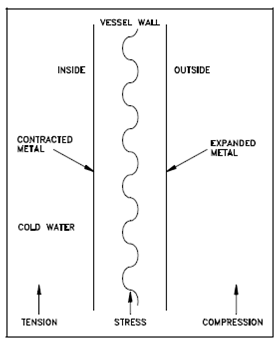Stress on Reactor Vessel Wall:
Thermal stresses are a main concern in reactor systems because of the magnitude of the stresses included. Along With rapid heating (or cooling) of a thick-walled vessel like as the reactor pressure vessel, one part of the wall might try to expand (or contract) although the adjacent section, that has not yet been exposed to the temperature change, tries to restrain it. Therefore, both sections are under stress. Below Figure described what takes place.
A vessel is assumed to be thick-walled or thin-walled based on comparing the thickness of the vessel wall to the radius of the vessel. It is commonly considered a thin-walled vessel if the thickness of the vessel wall is less than about 1 percent of the vessel's radius it is considered a thick-walled vessel if the thickness of the vessel wall is more than 5 percent to 10 percent of the vessel's radius. Whether a vessel along with wall thickness among 1 percent and 5 percent of radius is considered thin-walled or thick-walled depends on construction, the exact design, and application of the vessel.

Figure: Stress on Reactor Vessel Wall
While cold water enters the vessel, a cold water causes the metal on the within wall (left side of Figure) to cool before the metal on the outer. While the metal on the inside wall cools, it contracts, although the hot metal on the outside wall is still expanded. That sets up a thermal stress, placing the cold side in tensile stress and the hot side in compressive stress that could cause cracks in the cold side of the wall. Those stresses are described in further figures in the next chapter.
The cooldown and heatup of the reactor vessel and further of makeup water to the reactor coolant system could cause important temperature changes and by induce sizable thermal stresses. Slow controlled cooling and heating of the reactor system and controlled makeup water addition rates are essential to minimize cyclic thermal stress, therefore decreasing the potential for fatigue failure of reactor system elements.
Operating process is designed to decrease the magnitude and the frequency both of these stresses. Operational limitations involve cooldown and heatup rate limits for elements, temperature limits for placing systems in operation, and specific temperatures for specific pressures for system operations. These limitations allow material structures to change temperature at a more even rate and minimizing thermal stresses.